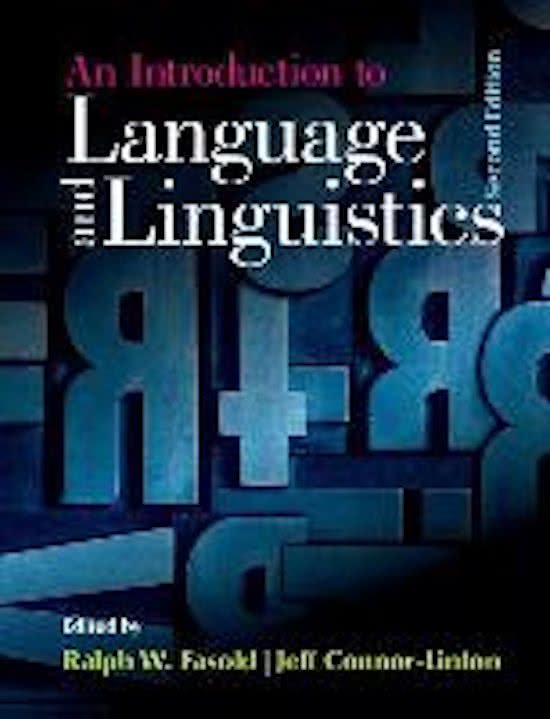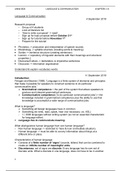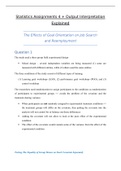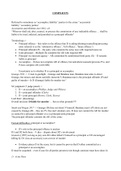Language & Communication
4 September 2018
Research proposal
- Group of 4 students
- Look at literature list
- ‘How to write a proposal’ -> read!
- Sign up for topic proposal before October 31st
- Sign up for tutorial before November 1st
- Prepare for the tutorial
Phonetics -> production and interpretation of speech sounds
Morphology -> syllable structure (creating words & meaning)
Syntax -> sentence structure (creating sentences)
Lexicon -> repository of linguistic elements with their meanings and structural
properties.]
Discourse/Culture -> declarative vs imperative sentences
Discourse -> information organisation
Understand & explain vocabulary words
11 September 2018
Introduction
Finegan and Besnier (1989): ‘Language is a finite system of elements and principles
that make it possible for speakers to construct sentence to do particular
communicative jobs.’
Grammatical competence = the part of the system that allows speakers to
produce and interpret grammatical sentences.
Communicative competence (‘to do particular communicative jobs’) = the
knowledge included in grammatical competence plus the ability to use that
knowledge to accomplish a wide range of communicative jobs.
What is language?
Something all foreign languages have in common
Something we write, read, speak, hear (not necessary, ex: ASL)
- +/- 3000 languages without writing system (so not an essential characteristic
for language either)
Language has to communicate meaning
What distinguishes human language from non-human language?
- Non-human language -> restricted to ‘here & now’ (immediate situation).
- Human language -> must be able to convey information about things at a
different time or place.
Characteristics of human language
Consists of a finite number of ‘signs’ (sounds, letters) that can be combined to
create an infinite number of meaningful units.
Discreteness: set of signs are discrete. Every language has its own set of
discrete units. What is discrete in one language, does not have to be in another.
1
,ANNA BOS LANGUAGE & COMMUNICATION CHAPTERS 1-4
Productivity: language is infinitely productive (a brilliant, colourful, original,
beautifully framed, etc… picture).
Arbitrariness: no relation between sound and meaning of a word (why is a chair
called a chair?). Sound inventory of a language = arbitrary. Patterns in which
sounds and words combine are arbitrary.
Modularity: people produce and interpret language using a set of component
subsystems in a coordinated way. Every module is responsible for part of the
language production/perception process. Modules: phonetic, morphology, syntax,
lexicon, pragmatics, discourse organization.
Simplification: Conceptualization (image/what do you want to say?) ->
sentence formation (1. Appropriate word 2. Structuring sentence
3. Pronunciation) -> articulation (motor movement).
Context dependent: words can have different meaning (bank/bank, write/right).
Constituency and recursion. ‘She’ can be ‘woman with the dark glasses’, etc.
- Allows for flexibility & structure
- Allows for recursion (= a property of systems which allows a process to be
applied repeatedly).
Variability: universal characteristics but difference between individual languages
(Vb: Limburg vs Friesland). Differ depending on situation and people spoken to.
Language is used to establish social identity (male/female, teenager/adult, etc).
‘Nonstandard’ varieties (‘incorrect’ languages) -> no such things because each
language and dialect of a language is a coherent, and equally valid, system.
Discrimination on the basis of language is based on two false propositions:
that one language is inherently better than others, and that people can be
taught to speak the ‘correct variety’.
What is communication?
The process of sharing information, especially when this increases
understanding between people or groups.
Process of using symbols to exchange meaning.
What distinguishes human from non-human communication?
Non-human (primate) communication:
- Largely innate (although recent research shows that they can be learned over
time).
- Gestures are used intentionally.
- Intentional gestures are used to request/demand action from others (getting
attention is essential).
- Understanding and production of gestures is based on an understanding that
others have goals and expectations about what others are going to do.
- Communication for their own goals, there are no shared goals.
Human communication:
- More complex because of social-cognitive infrastructure not only covers skills for
understanding individual intentionality, but skills for shared intentionality.
- Ability to mind read and ‘collect’ mental representations (experience) allows for
the generation of joint attention and joint goals.
- Motives for shared intentionality: requesting, informing, sharing emotions and
attitudes.
2
,ANNA BOS LANGUAGE & COMMUNICATION CHAPTERS 1-4
-
Underlying principle: cooperation and intentionality, joint goal = successful
communication. You want people to understand you and vice versa.
Criticism:
This model suggests that communication is a one way process
Model fails to show the influence of context
Not able to reflect human to human communication
- Physical context -> noise
- Psychological context -> mood you are in
Criticism:
Technical
Communication is more than a process of sending and receiving messages
We cannot consciously decide to stop communicating
Role of context beyond physical and psychological context is not represented.
3
, ANNA BOS LANGUAGE & COMMUNICATION CHAPTERS 1-4
- Relational context -> relation to that person
- Social context -> setting
- Cultural context -> how individuals are raised/how culture affects behaviour
- Sender and receiver both have an influence in the process
Basic function of verbal communication
Helps to define reality
Helps to organise complex ideas and experiences
Helps to think
Helps to shape attitudes about the world
Communication: very little of what we communicate happens with the use of words
(+/- 7%). Body language plays a big part in communication (+/- 55%).
Principles of verbal communication:
A rule governed system of symbols to share meaning
System has been agreed upon
Symbols are abstract, ambiguous, abstract
Rules that determine our use of symbols are phonology, semantics, syntax,
pragmatics
Forms of communication
- Intrapersonal communication (thoughts)
- Interpersonal communication (face-to-face)
- Group communication (there is a goal)
- Public communication (ex: mayor to a city)
- Mass communication (ex: if it’s on television)
4












